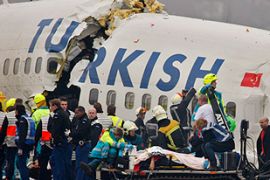‘Stalled engine’ clue in jet crash
Chief investigator says problem with engines may have caused plane crash in Amsterdam.

Pieter van Vollenhoven, the head of the agency investigating the crash, said the plane had fallen almost directly out of the sky, which suggested its engines could have stalled.
But he added the reason for an engine failure had not been established.
Sandra Groenendal, a spokeswoman for the Dutch Safety Authority, said engine failure was still only “one of the possible scenarios” for the crash.
Van Vollenhoven said an analysis of the plane’s flight data recorders in Paris could be completed as early as Friday, but a preliminary finding would probably not be released until next week.
‘Enormous crash’
Turkish Airlines said the aircraft had undergone routine maintenance on February 19, and that it delayed a flight four days later to replace a faulty caution light.
The airline said the fault should not be seen as a potential cause of the crash
| In video | ||
|
|
Survivors from the crash said the engine noise stopped, the plane shuddered and then fell out of the sky tail-first.
Henk Heijloo, a passenger on the flight, said the last message he heard from the captain was for the flight crew to take their seats.
“We were coming in at an odd angle, and I felt the pilot give the plane more gas,” he said.
Heijloo said it felt like the pilot was trying to abort the landing, because the noise of the plane came up. But then he realised the landing was too rough, and a moment later felt an enormous crash.
It is believed the muddy field the plane landed in absorbed the force of the impact, and helped to reduce the number of deaths.
Safety history
The aircraft, which was carrying 135 people, broke into three pieces after hitting the ground around 3km short of the runway. The fuselage tore in two near the cockpit and the tail was ripped off.
Despite the catastrophic impact, the wreckage did not burn and scores of people walked away.
The crash in Amsterdam was Turkish Airlines’ fourth fatal incident in 15 years, according to the Ascend Online Fleets database.
The carrier’s last fatal crash was on January 8, 2003, when an RJ-100 built by BAE Systems Plc went down in fog, killing more than 70 passengers and five crew members.
In April 1999, six died when a Boeing 737-400 carrying only crew crashed shortly after take-off, and in 1994, 57 people were killed when another 737 hit terrain on its landing approach.
All three accidents occurred in Turkey.
